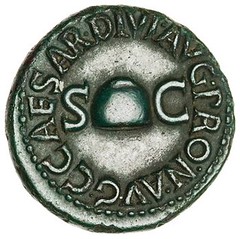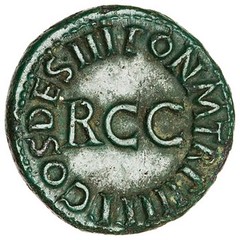
PREV ARTICLE
NEXT ARTICLE
FULL ISSUE
PREV FULL ISSUE
ARTICLE REVIEW: CALIGULA'S QUADRANS
While we often feature reviews of numismatic books, we sometimes review articles as well. Chris Salmon (author of the just-published "The Silver Coins of Massachusetts" submitted these thoughts on an article just published in The Numismatic Chronicle. Thanks! Chris notes that "The article deals with one of the enduring puzzles of Julio-Claudian numismatics: the meaning of the Caligula quadrans."
-Editor


I was pleased to find the latest issue of The Numismatic Chronicle (2010) from the Royal Numismatic Society, in my mailbox today. It has an article by David Woods that offers a new answer to a longstanding numismatic riddle: the meaning and purpose behind the well-known Caligula quadrans of 39-41. I think Woods's paper is an important contribution to Julio-Claudian numismatics that should spur lively discussion. I've summarized the main points of his thesis below: The coin (see link below to an example in the American Numismatic Society Collection) has on its obverse a pileus, which is a cap given to newly emancipated slaves upon their assumption of citizenship. On the reverse is a bold, though opaquely cryptic, central legend of the letters "RCC", surrounded by the formulaic shorthand description of the emperor's powers and offices. The purpose of the pileus and the (related or not) meaning of the RCC inscription remain in dispute and have led to differing hypotheses since the late 18th century, with most modern observers echoing the original hypotheses of Eckel from 1796, who thought that the RCC inscription referred to Caligula's remission of the 0.5% sales tax (hence remissa ducentesima), with the pileus a reference to restored liberty deriving from return of elections to the popular comitia from the Senate. Eckel thus thought the obverse and reverse commemorated separate distinct acts of the emperor. The Eckel explanation for the RCC inscription is commonly found in modern numismatic references, dealer price lists, and auction catalog descriptions. Some of these observers differ from Eckel in interpreting the obverse pileus—holding that the liberty cap depiction also commemorated Caligula's tax relief—or else ignore the question of obverse symbolism altogether. Other authors, including Vagi, are somewhat (and, I think, most appropriately and wisely) cautious, stating that the RCC may be a reference to the tax remission. Woods points out that classicist and Caligula biographer Anthony A. Barrett took a fresh approach. Barrett quite reasonably felt that the obverse and reverse should refer to the same event and that the event should be contemporary with the earliest issue of the quadrans variety (or late 39 when Caligula assumed the Consulship for the third time). The tax relief was earlier, in 38, and therefore would have been old news, already revoked by the time of the quadrans issue. Early historical records also differ in describing the remitted tax as either 1% or 0.5%. As for the obverse, Barrett disputed Eckel's interpretation on three different grounds: 1. The populace would not have considered (an essentially cosmetic) restoration of elections to the popular assemblies as liberating; 2. The restoration occurred in 38 (and, again, was "yesterday's news" as of the late 39 date of the first quadrans); 3. The use of a pileus to symbolize liberality—as, for example, tax-relief—was a third century phenomenon, and therefore anachronistic in the context of interpreting first century iconography. Barrett put forth a new interpretation, unifying the purpose of obverse and reverse elements in celebrating a single contemporary event: the execution of Gaetulicus, Governor of Upper Germany, in late 39, for his plot against Caligula. In this context, the pileus would symbolize the death of a threat to liberty in the same way that it was used by Brutus on the famous Eid Mar denarius to celebrate the execution of Julius Caesar. Barrett found no parallel in contemporary non-numismatic epigraphy for RCC, but suggested that it could be an abbreviation for Restituti Concordia Consensus or something comparable. Although Woods recognizes that Barrett "pays proper attention to chronology," he finds the arguments and conclusions of Barrett (and his predecessors) unsatisfactory on several grounds and offers a new interpretation of the Caligula quadrans. Unlike the Eid Mar denarius, the Caligula quadrans lacks daggers. The coin is neither too small for daggers (despite Barrett arguments to the contrary), nor Caligula too timid to use such symbolism (as Woods illustrates). Woods concludes that "daggers played no part in the event that Caligula celebrated." Rather, "one should focus on the symbolism of the pileus itself and not be distracted by the superficial resemblance between the obverse of the quadrans and the reverse of the Brutus denarius." Barrett, says Woods, also ignores the fact that the reverse and obverse types were limited to the quadrans (one quarter of an as). Wood finds it implausible that such a high level conspiracy by a major figure would be celebrated on the lowly quadrans and not on a denomination used primarily among the army and societal elite, as is normally seen for such numismatic commemorations. Woods's interpretation of the Caligula quadrans is that the liberty it celebrates is the liberty of all free Roman citizens, with the pileus as a their symbol. He reasons that it was Caligula's crackdown on those illegally claiming citizenship that is the focus of the coin's commemoration. This proper enforcement of the rules of citizenship would theoretically play well among the greater masses of the population who normally encounter the quadrans in everyday exchange. This same segment of the population might also be most at risk of competition from an influx of false citizens, particularly in a milieu of increasing scarcity. We don't know exactly when the new social measures were implemented by the emperor, but his actions probably coincided with the financial crisis of late 39. This would, of course, be consistent with the chronology indicated by the coins's inscriptions. As for the meaning of the RCC reverse inscription, Woods posits that it could be Res Civium Conservatae ("The interests of the citizens has been preserved"), or something closely related to this. I've always wondered how the average Roman citizen would be expected to meaningfully and unambiguously decipher severely abbreviated coin inscriptions, although in the context of the current argument (with the message putatively aimed at a largely illiterate underclass) it may matter little. Woods's hypothesis for the Caligula quadrans seems quite plausible, and is probably the single best explanation to account for all of the available evidence. Time will tell if it will be accepted or if a more satisfactory argument appears. It should, in any event, lead to a reappraisal of and perhaps greater interest in the coins by the numismatic community.
To view the coin's catalogue entry, see:
1967.153.112 Rome, / 39 / AE,Quadrans
(numismatics.org/collection/1967.153.112)
The Numismatic Bibliomania Society is a non-profit organization promoting numismatic literature. See our web site at coinbooks.org. To submit items for publication in The E-Sylum, write to the Editor at this address: whomren@gmail.com To subscribe go to: https://my.binhost.com/lists/listinfo/esylum All Rights Reserved. NBS Home Page Contact the NBS webmaster 
|